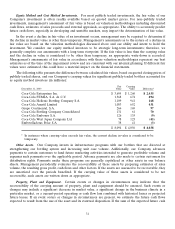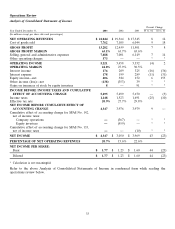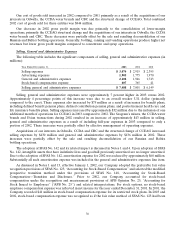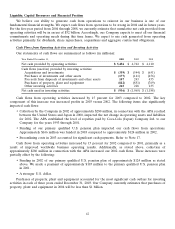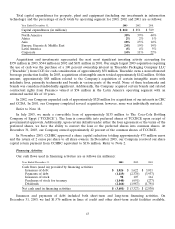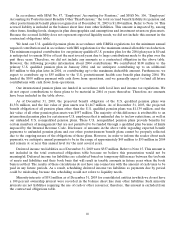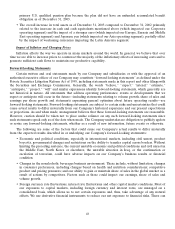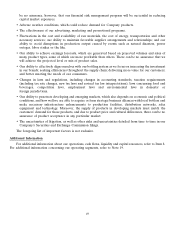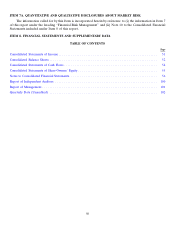Coca Cola 2003 Annual Report Download - page 44
Download and view the complete annual report
Please find page 44 of the 2003 Coca Cola annual report below. You can navigate through the pages in the report by either clicking on the pages listed below, or by using the keyword search tool below to find specific information within the annual report.
The effective tax rate for 2002 of 27.7 percent included the impact of the following:
• the effective tax rate for our share of the gain on the sale of Kaiser S.A. interests of approximately
39 percent;
• we concluded it was more likely than not that tax benefits would not be realized on the write-down of
certain investments, primarily in Latin America; thus we recorded a valuation allowance to offset the
future tax benefit resulting in an increase of our effective tax rate; and
• the effective tax rate for all other pretax income of approximately 27 percent.
During the first quarter of 2000, the U.S. and Japan taxing authorities entered into an Advance Pricing
Agreement (‘‘APA’’) whereby the level of royalties paid by Coca-Cola (Japan) Company, Ltd. (our ‘‘Subsidiary’’)
to our Company was established for the years 1993 through 2001. Pursuant to the terms of the APA, our
Subsidiary filed amended returns for the applicable periods reflecting the negotiated royalty rate. These
amended returns resulted in the payment during the first and second quarters of 2000 of additional Japanese
taxes. The effect on our financial performance and our effective tax rate was not material, due primarily to
offsetting tax credits utilized on our U.S. income tax returns. The majority of the offsetting tax credits were
realized in the first quarter of 2002.
Looking into 2004 and for the foreseeable future, based on current tax laws, the Company’s effective tax
rate on operations is expected to be approximately 25.5 percent.
Cumulative Effect of Accounting Change for SFAS No. 142, Net of Income Taxes
The cumulative effect of adopting SFAS No. 142 as of January 1, 2002 resulted in a noncash, after-tax
decrease to net income of $367 million for Company operations and $559 million for the Company’s
proportionate share of its equity method investees. The adoption of this accounting standard resulted in a pretax
reduction in 2002 amortization expense of approximately $60 million, and an increase in 2002 equity income of
approximately $150 million. Refer to Notes 1 and 4.
Volume
We measure our sales volume in two ways: (1) gallons and (2) unit cases of finished products. ‘‘Gallons’’ is a
unit of measurement for concentrates, syrups, beverage bases, finished beverages and powders (in all cases,
expressed in equivalent gallons of syrup) for all beverage products which are reportable as unit case volume.
Most of our revenues are based on gallon sales, as discussed under Item 1 and MD&A heading ‘‘Net Operating
Revenues.’’ Gallon sales and unit case volume are not necessarily equal during any given period. Items such as
seasonality, bottlers’ inventory practices, supply point changes, timing of price increases and new product
introductions can create differences between gallon sales and unit case volume.
Although most of our Company’s revenues are not based directly on unit case volume, we believe unit case
volume is one of the measures of the underlying strength of the Coca-Cola System because it measures trends at
the consumer level. The Coca-Cola System sold approximately 19.4 billion unit cases of our products in 2003 and
approximately 18.7 billion unit cases in 2002. Approximate 2003 and 2002 unit case volume growth results are as
follows:
Percentage Change
2003 vs. 2002 2002 vs. 2001
Worldwide 4 5
North America operations 2 6
International operations—total 5 5
Africa 5 7
Asia 410
Europe, Eurasia & Middle East 5 5
Latin America 4 2
41


